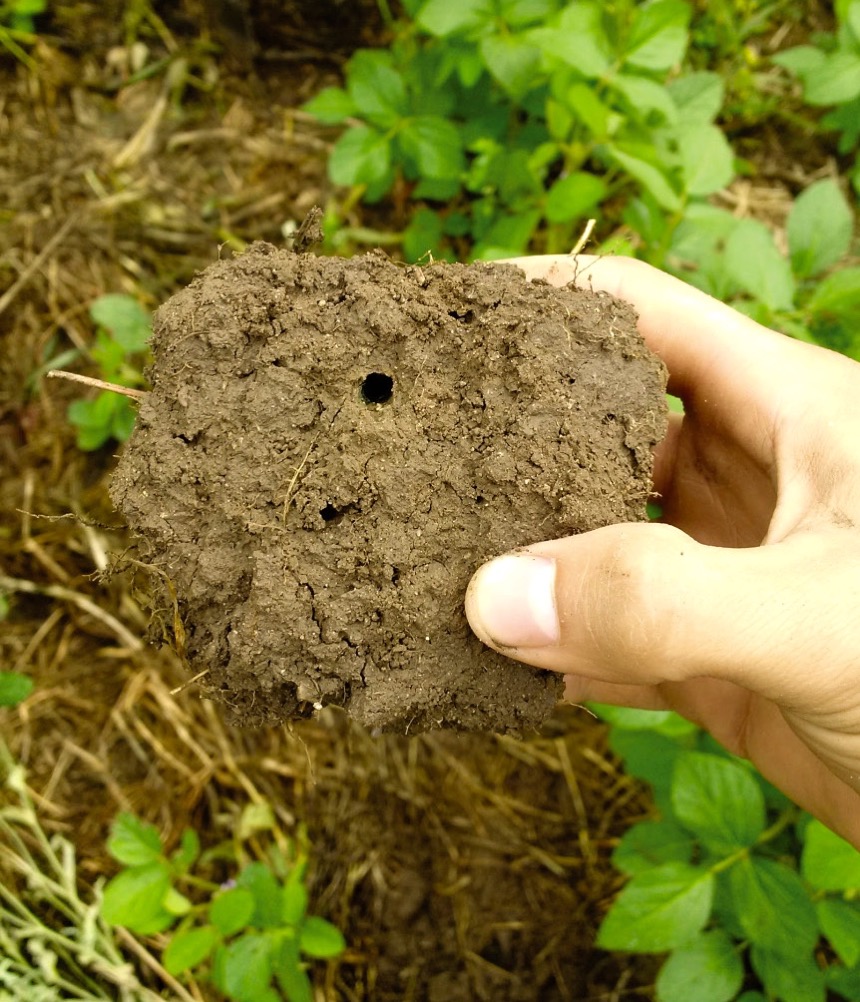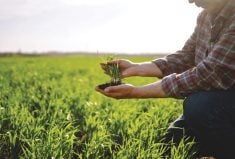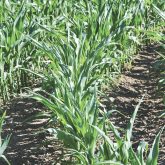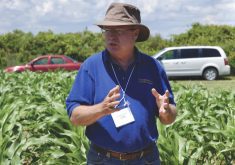It’s a curious trend. “Soil health” is one of the great buzz phrases of modern agriculture. Admittedly, it’s just words to some, yet for a dedicated and growing number of producers, it’s a primary goal.
Yet if you ask the average farmer if they test their soil once every three years, as recommended, the answer more often than not, is “no.” Much of the time, soil testing is perceived as a cost and therefore something to be avoided, and of course it can also be time-consuming.
Read Also

Agronomists share tips for evaluating new crop products and tech: Pt. 3
With new products, new production practices and new technology converging on the agriculture industry at a frenetic pace in recent…
Depending on the results, too, there can be serious question about its overall value.
Enter the Solvita test. Although it’s been available to Eastern Canada growers for about five years, its acceptance hasn’t been what its proponents had hoped for. The test was developed by Drs. Mary Droffner and Will Brinton of Woods End Laboratories of Mt. Vernon, Maine, combining their decades of expertise on soil properties with the technology that can yield quicker and more comprehensive results.
The test itself measures carbon dioxide respiration using gel-based “paddles” that turn colour based on the amount of carbon dixoide in the soil. Unlike previous CO2 tests that could take as long as a week, the Solvita test renders a result within 24 hours.
CO2 respiration indicates the presence of microbes in the soil, with the rate and quantity of CO2 production reflecting the activity of that soil life. As a grower engages in more sustainable practices such as cover cropping or reduced tillage, soil organic matter accumulates via humified roots and other plant residues. This organic matter then supports rich microbial life.
However, the presence of CO2 also indicates the availability of nitrogen and phosphorus, which are components of plant residues, microbes and humus.
According to Dr. George Lazarovits, research director with A&L Canada Laboratories in London, Ont., the Solvita test also provides a link between CO2 respiration and potentially mineralisable nitrogen (PMN) in soil. In 1994, Dr. Dan Murphy led a research team at the University of Western Australia with a detailed analysis of soil biology and crop production (in wheat) on 14 farms.
“They looked at how the statistics on various factors explained the differences in yield between the high production sites and those areas they called the underperforming sites,” says Lazarovits. “Of about 30 per cent of the variables that explained the underperforming sites — the difference between the high and low production sites — the highest correlation by far was microbial respiration — the total microbial counts. When they broke this down further, they found it was actually related to the reserves of nutrients that were stored in this population of microbes that were released to the plants at the time that they were producing grain.”
Their research determined that 80 per cent of nutrients required by a wheat crop are stored in the microbial populations.
This is the potential mineralisable nitrogen, and it’s what they found to be the most important factor, which then relates to the amount of nutrients stored in the microbes.
In other words, these microbes store nitrogen, potassium, magnesium, calcium and zinc, and as they die off, they act as slow-release fertilizer.
A faster test
In 1994, the limiting factor for measuring soil respiration was time. It could take up to a week to generate enough carbon dioxide in a test-tube sample to derive any meaningful data. Today, the Solvita test can do that in one day.
As with other tests, however, it isn’t a single measurement that provides the greatest value. The first measurement is simply a benchmark, and Lazarovits is the first to say that while it will give you some baseline values on the potential mineralisable nitrogen available in a field, it won’t provide a definitive word on the overall soil health profile.
It’s a little like a physical exam, he says: if you get one every year, then you can look at change over time, which gives you a better idea of your health status.
“Solvita should be a test that you would do on a regular basis to see if you’re actually pushing up those microbial counts,” Lazarovits says. “A single test is not all that informative but if you do it every year and you’re doing rotations and you’re putting on manure, and your respiration is going up on a yearly basis, you will notice that your yields are going up on a yearly basis. You’ll then be able to correlate — just as they have at the Solvita lab — between crop yield and soil respiration.”
Different test altogether
Some might wonder if a soil biology test is actually important. Physical and chemical properties in any soil are the standards, and the information derived from testing them is all that’s been necessary for years.
Even so, Jake Munroe, soil fertility specialist with the Ontario Ministry of Agriculture, Food and Rural Affairs (OMAFRA) is a proponent of measuring soil biological activity.
With a conventional test, Munroe says, a grower is getting an analysis based on chemical extractions for a variety of nutrients, as well as pH. With those extractions, there’s a history of research that has used those data from a variety of soils and calibrated fertility recommendations accordingly. Solvita is quite different in that it’s not a chemical extraction from the soil, it’s an incubation of the soil, particularly the CO2 “burst” test.
Yet Munroe also concedes the uptake by farmers has been limited in spite of the information the test can provide. “What the body of evidence shows from research that’s been done on this is that CO2 burst is providing an estimate of potential biological activity or potential soil function in a broad sense.”
The Solvita test is more strongly correlated to active organic matter, i.e. the short-term organic matter made up of microbes, plant sugars, microbial by-products and relatively easily consumed materials that can serve as a food source for the microbes.
The important point from Munroe’s perspective is that the Solvita test provides more than a proxy for soil organic carbon, and it certainly isn’t merely a replacement for the standard soil test.
“I look at something like the Solvita test or the CO2 respiration test as providing a bit more of an integrated measure of the soil’s biological capacity,” says Munroe. “It provides additional information, so I don’t think it replaces the need for conventional soil testing. It’s certainly not a magic bullet of a soil test, and it doesn’t stand alone as ‘the’ soil test. But to me, it seems to be a useful tool based on the research that’s been done and the theory behind it.”
The challenge for both Munroe and Lazarovits goes back to the perception of any soil test — conventional or Solvita — as a cost and not as an investment or a process of obtaining valuable information and insight into a grower’s soil. That’s a tough sell for anyone and Munroe believes there are those growers who do conduct regular soil tests and who might also use the Solvita test if they’re interested in exploring the link between cropping practices, yield and enhanced soil health. But is the Solvita test one that’s going to provide information that will solve soil fertility management issues? He doesn’t believe it will at this point.
“In the future, there is a potential to better integrate soil biological tests with our fertility recommendations,” says Munroe. “It’s another piece of the puzzle — a very important component of soils. In some ways, we know a lot about soils and in other ways, we have a lot to learn. I think there’s a demand to have tests that can produce a better sense of where farmers are at in terms of a soil health perspective. And this is one option.”
Of course there are also several other methods of determining soil health that don’t cost a lot of money (although they may lack the detail of soil analysis): one is to go out in the field with a shovel. Another is to gauge crop performance during a stressful year.
The resources are there — and have been for years — along with extension personnel, advisers and researchers who are steering growers in the direction of gleaning more information on soil health. What’s changing now is that more growers are following the leads from those individuals.
Ongoing research
Lazarovits agrees there are more growers interested in improving soil and plant health. He’s seeing it in the number of farmers who are incorporating more beneficial practices such as cover crops or assessing their tillage practices.
He sees a tremendous uptake of controlled traffic measures in Western Canada, including growers who are making their own equipment modifications to enable the practice.
And he insists that there’s more research that’s yielding interesting insights into crop health.
One such example involves A&L Labs and research to characterize microbial communities on the roots and inside the plant and on the leaves.
They tried to determine the difference between a highly productive field with a 300 bu./ac. yield potential and an average field with 150 bu./ac., but they were only looking for broad differences across the two fields. When they found none, the research was viewed as a failure.
It wasn’t until they were conducting a comparison for a U.S. company that they found the key. Different microbial communities can be found in different regions of a field. In higher producing areas, there will be different microbes than in the lower producing regions.
Lazarovits uses a human parallel of selecting bacteria from 10,000 people; it’s likely that there’d be an average profile of microbial communities across a large survey. But if you sampled from people who are sick versus those who are in good health, you’d see a huge variation.
The thinking now is that if growers could manage their microbes in order to make the low-yielding parts of their fields a lot more like the high-yielding areas, the impact on overall yield could be impressive.
Then, on top of that, there’d be the potential to grow the microbes on even the highest yielding soils in order to make them yield that much more.
“We’re finding huge differences,” says Lazarovits. Apparently, we’ve only just begun.















